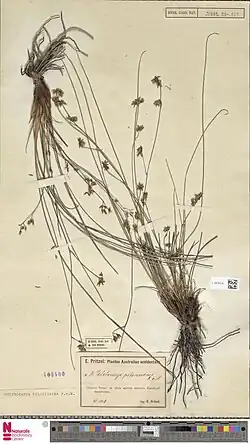Phlebocarya pilosissima
| Phlebocarya pilosissima | |
|---|---|
 | |
| Scientific classification | |
| Kingdom: | Plantae |
| Clade: | Tracheophytes |
| Clade: | Angiosperms |
| Clade: | Monocots |
| Clade: | Commelinids |
| Order: | Commelinales |
| Family: | Haemodoraceae |
| Genus: | Phlebocarya |
| Species: | P. pilosissima |
| Binomial name | |
| Phlebocarya pilosissima | |
| Synonyms[3] | |
| Phlebocarya ciliata var. pilosissima F.Muell. | |
Phlebocarya pilosissima is a plant in the Haemodoraceae family,[1] native to Western Australia.[3]
Description
Phlebocarya pilosissima has flattened to terete leaves. The leaf blade is 14-35 cm by 0.6-2 mm.[4] Leaf surfaces can be smooth to densely covered with sharp rigid bristly hairs (and on the margins).[4] The flower heads vary from being about half as long to longer than the leaves.[4] The scape is hairy and the bracts have branched hairs along the margin, while the pedicels are densely hairy.[4] The style is trifid and there are three stigmas.[4]
Taxonomy & etymology
The plant was first described as Phlebocarya ciliata var pilosissima by Ferdinand von Mueller in 1873,[1][5] but later in 1873 George Bentham erected it to the species Phlebocarya pilosissima.[1][2] The species epithet, pilosissima, comes from the Latin, pilus ("hair")[6] which gives the adjective, pilosus,[7] and its superlative, pilosissima,[6] thus describing the plant as being the "hairiest".
References
- ^ a b c d "Phlebocarya pilosissima". Australian Plant Name Index, IBIS database. Centre for Plant Biodiversity Research, Australian Government.
- ^ a b Bentham, G. (1873). "CXXIII. Amaryllideae". Flora Australiensis. 6: 425 – via BHL.
- ^ a b "Phlebocarya pilosissima (F.Muell.) Benth. | Plants of the World Online | Kew Science". Plants of the World Online. Retrieved 9 April 2021.
- ^ a b c d e T.D.Macfarlane (2020). "Phlebocarya pilosissima". Flora of Australia. Canberra: Australian Biological Resources Study, Department of Agriculture, Water and the Environment. Retrieved 9 April 2021.
- ^ Mueller, F.J.H. von (1873). "Haemodoraceae". Fragmenta Phytographiae Australiae. 8 (59): 23 – via BHL.
- ^ a b Stearn, William T. (2004), Botanical Latin, Timber Press, p. 467, 98, OL 4013730W, Wikidata Q101497897
- ^ "pilosus,-a,-um". www.plantillustrations.org. Retrieved 10 April 2021.
External links